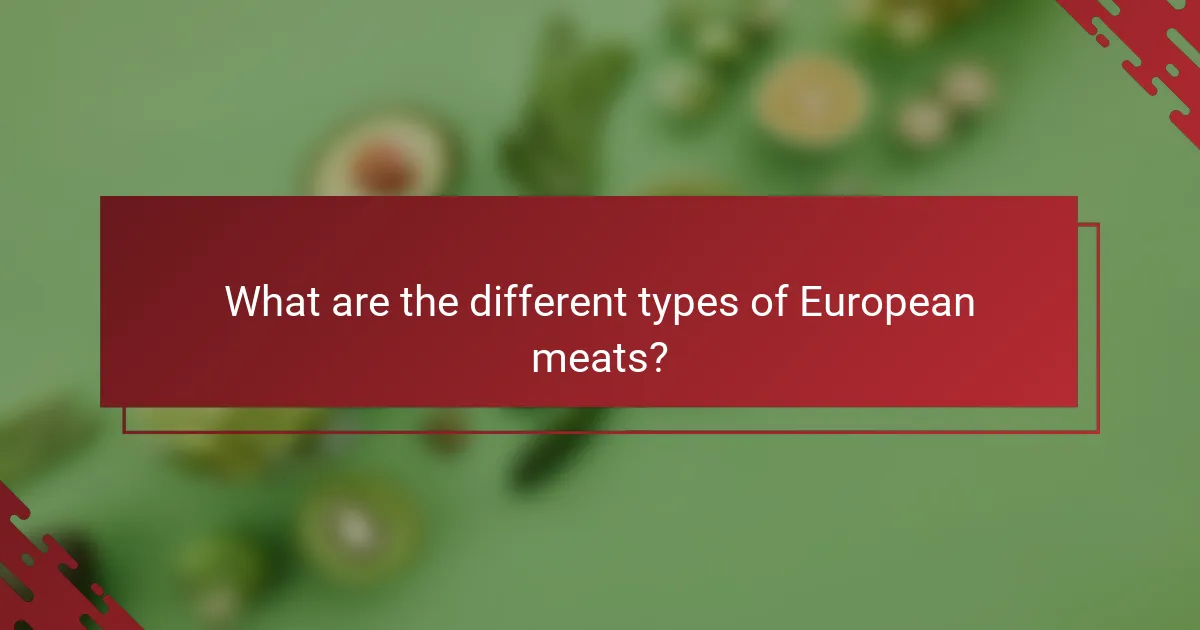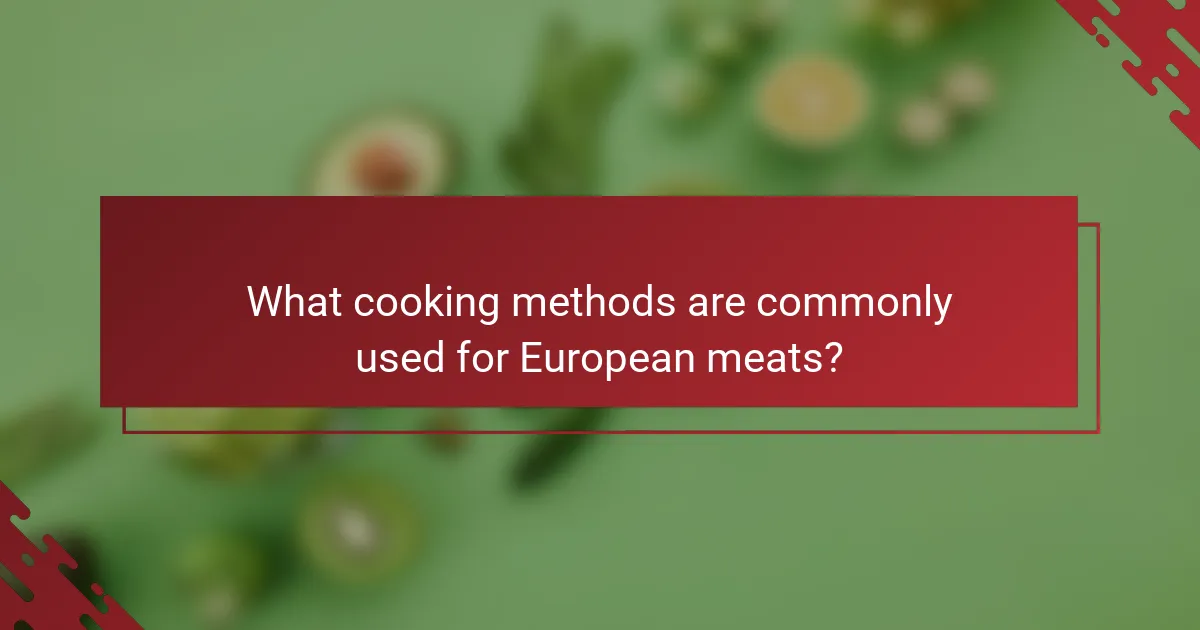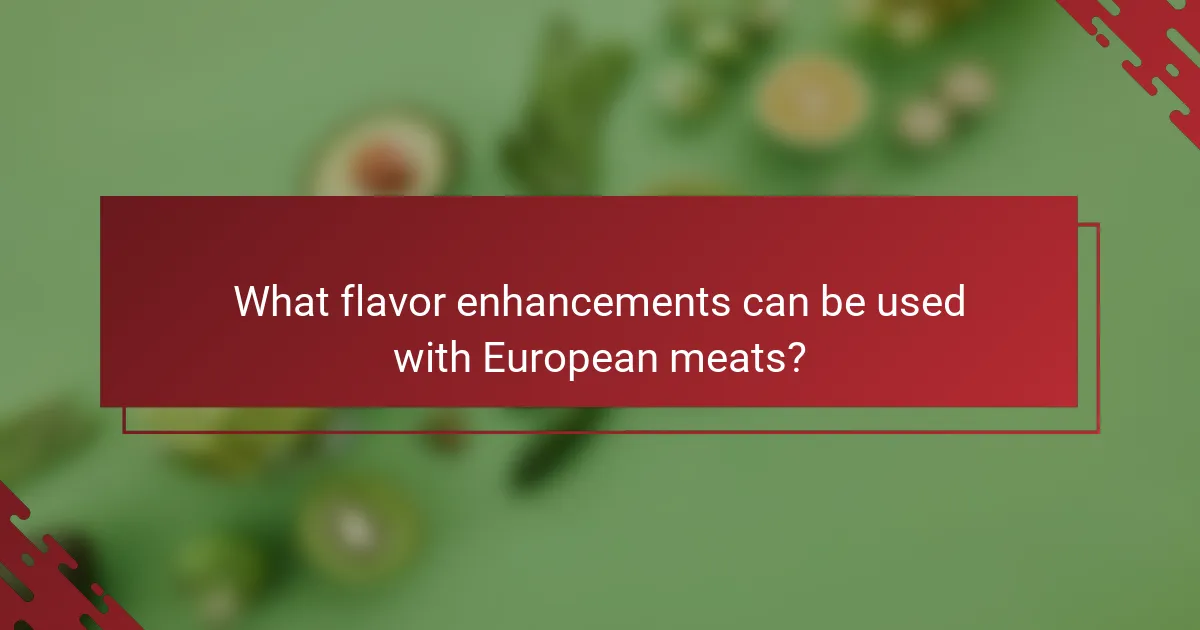European meats encompass a variety of types, including pork, beef, lamb, and poultry, each with distinct regional significance and culinary applications. Countries such as Germany and Italy favor pork, while beef is a staple in France and the UK, often featured in traditional dishes like steak and roasts. Lamb is integral to Mediterranean cuisine, particularly in Greece and Spain, and poultry, including chicken and duck, is widely consumed across the continent. The article will detail common cooking methods such as roasting, grilling, braising, and stewing, alongside popular flavor enhancements like herbs, spices, and marinades that elevate the taste of these meats in various European culinary traditions.

What are the different types of European meats?
European meats include various types such as pork, beef, lamb, and poultry. Pork is widely consumed in countries like Germany and Italy. Beef is popular in France and the UK, often used for dishes like steak and roasts. Lamb is commonly associated with Mediterranean cuisine, particularly in Greece and Spain. Poultry, including chicken and duck, is prevalent across Europe. Each type of meat has unique regional cuts and preparation methods, contributing to diverse culinary traditions. For instance, Italian prosciutto is a famous cured pork product. French coq au vin features chicken braised with wine, showcasing the regional flavors.
What are the most popular cuts of meat in Europe?
The most popular cuts of meat in Europe include beef, pork, lamb, and chicken. In beef, cuts like ribeye and sirloin are favored. Pork cuts such as tenderloin and shoulder are widely consumed. Lamb chops and leg cuts are popular in many regions. Chicken breast and thighs are staples across Europe. These preferences vary by country, influenced by local cuisines and traditions. For example, Italy emphasizes prosciutto and pancetta, while France favors duck confit. The popularity of these cuts reflects culinary practices and cultural significance throughout Europe.
How are these cuts categorized by animal type?
Cuts of meat are categorized by animal type into beef, pork, lamb, and poultry. Each category has distinct cuts that vary in flavor and texture. For example, beef includes cuts like ribeye and sirloin. Pork features cuts such as tenderloin and shoulder. Lamb offers cuts like leg and rack. Poultry includes chicken breast and thigh. These categorizations help in cooking methods and flavor profiles. Specific cuts are suited for grilling, roasting, or braising. Understanding these categories enhances culinary practices and meal preparation.
What are the unique attributes of each cut?
The unique attributes of each meat cut vary significantly. For example, the ribeye cut is known for its marbling, which enhances flavor and tenderness. The sirloin cut is leaner and has a firmer texture, making it suitable for grilling. The tenderloin is the most tender cut, ideal for quick cooking methods like pan-searing. The chuck cut contains more connective tissue, requiring slow cooking to become tender. The brisket cut has a rich flavor and is often used in barbecuing due to its fat content. Each cut’s unique attributes are influenced by the muscle’s location and usage in the animal, affecting flavor, tenderness, and cooking methods.
How does the origin of European meats influence their flavor?
The origin of European meats significantly influences their flavor. Different regions in Europe have unique farming practices, climates, and feed sources. For instance, meats from Spain, like Iberian ham, are known for their rich, nutty flavor due to acorn-fed pigs. In contrast, Scandinavian meats often feature a milder taste, influenced by their colder climate and traditional breeding methods. The terroir, or environmental conditions, also plays a crucial role in flavor development. Historical practices, such as curing and smoking, further enhance the distinct flavors of meats from specific areas. For example, Italian prosciutto undergoes a lengthy aging process that contributes to its complex taste profile. Overall, the geographical and cultural context shapes the flavor characteristics of European meats.
What regional differences exist in European meat production?
European meat production varies significantly by region. Northern Europe, particularly Scandinavia, focuses on pork and beef. This region has a colder climate, influencing livestock breeds and production methods. Southern Europe, like Spain and Italy, emphasizes lamb and goat meat. The Mediterranean climate supports different farming practices and meat preferences. Central Europe, including Germany and Austria, has a strong tradition of sausage-making, reflecting cultural tastes. Eastern Europe produces a variety of meats, with a focus on poultry and game. The diverse agricultural practices and consumer preferences across these regions shape the overall landscape of meat production in Europe.
How do traditional farming practices affect meat quality?
Traditional farming practices enhance meat quality through better animal welfare and natural diets. Animals raised in traditional systems often have access to pasture, which improves their overall health. Healthier animals produce meat with improved flavor and texture. Studies indicate that grass-fed beef has higher omega-3 fatty acids and antioxidants compared to grain-fed counterparts. Additionally, traditional methods often involve slower growth rates, allowing for more developed muscle and fat marbling. This results in meat that is tender and flavorful. Research by the University of Reading shows that traditional farming leads to superior meat quality, as animals experience less stress and better living conditions.

What cooking methods are commonly used for European meats?
Common cooking methods for European meats include roasting, grilling, braising, and stewing. Roasting is often used for larger cuts like lamb or beef, allowing for even cooking and flavor development. Grilling is popular for sausages and pork, providing a smoky flavor. Braising combines cooking in liquid with slow heat, ideal for tougher cuts, enhancing tenderness. Stewing involves simmering smaller pieces in liquid, creating rich flavors. These methods are traditional across various European cuisines, reflecting regional preferences and ingredient availability.
What are the traditional cooking techniques for European meats?
Traditional cooking techniques for European meats include roasting, braising, and grilling. Roasting involves cooking meat in an oven, allowing for even heat distribution. Braising combines both wet and dry heat, typically searing the meat first and then simmering it in liquid. Grilling uses direct heat from below, imparting a distinct charred flavor. Other methods include stewing, which cooks meat slowly in liquid, and poaching, where meat is submerged in simmering water or broth. These techniques have historical roots in European culinary traditions, often reflecting regional flavors and available ingredients. For example, the French often use braising for tougher cuts, while Italians favor grilling for their meats.
How does roasting differ from braising in meat preparation?
Roasting and braising are two distinct meat preparation methods. Roasting involves cooking meat in an oven with dry heat. This technique typically results in a browned, crispy exterior. Roasting is ideal for larger cuts of meat, such as whole chickens or roasts. It usually requires less moisture, focusing on the natural juices of the meat.
Braising, on the other hand, combines moist and dry heat. This method starts with browning the meat in fat, followed by slow cooking in liquid. Braising is suitable for tougher cuts of meat, as the slow cooking process tenderizes them. The added liquid, often broth or wine, enhances flavor and moisture.
The primary difference lies in the cooking environment and moisture levels. Roasting relies on dry heat, while braising uses a combination of dry heat and liquid. This distinction affects texture, flavor, and the types of meat best suited for each method.
What role does grilling play in European culinary traditions?
Grilling is a fundamental cooking method in European culinary traditions. It enhances the flavors of various meats and vegetables. Grilling is especially popular in Mediterranean countries, where it is often associated with outdoor gatherings. The method allows for the development of a smoky flavor through direct exposure to heat. In Germany, grilling is a central part of social events, especially during summer festivals. Many European cuisines have specific grilling techniques, such as the Italian “grigliata” or Spanish “asado.” Grilling also promotes healthier cooking by allowing excess fats to drip away. Overall, grilling is integral to the cultural and social fabric of European dining experiences.
How can modern cooking methods enhance traditional meat dishes?
Modern cooking methods can enhance traditional meat dishes by improving flavor, texture, and cooking efficiency. Techniques such as sous vide allow for precise temperature control, resulting in tender and juicy meats. High-heat methods like grilling or searing can create a flavorful crust while retaining moisture inside.
Additionally, modern marinades and brining techniques can infuse meats with deeper flavors. The use of smoking and sous vide together can add complexity to the meat’s taste profile. Advances in technology, such as digital thermometers, ensure optimal cooking temperatures are achieved consistently.
Research indicates that these methods can reduce cooking times significantly while maintaining or improving the quality of the dish. For example, sous vide cooking can cut cooking time by up to 50% compared to traditional methods while enhancing tenderness.
What are the benefits of sous-vide cooking for meat?
Sous-vide cooking for meat offers precise temperature control, resulting in even cooking throughout. This method ensures that meat retains moisture, leading to juicier and more flavorful results. Sous-vide also allows for the breakdown of tough connective tissues, enhancing tenderness. The low and slow cooking process can improve the overall texture of the meat. Additionally, sous-vide cooking minimizes the risk of overcooking, maintaining the meat’s intended doneness. Studies show that sous-vide can preserve nutrients better than traditional cooking methods. Overall, sous-vide enhances both the flavor and quality of meat dishes.
How does smoking impact the flavor profile of meats?
Smoking enhances the flavor profile of meats by infusing them with rich, complex flavors. The process involves exposing the meat to smoke from burning or smoldering materials, typically wood. This exposure creates a unique taste that varies depending on the type of wood used. Common woods like hickory, mesquite, or applewood impart distinct flavors. Smoking also adds a layer of smokiness that can enhance the natural flavors of the meat. Additionally, the smoke contributes to the formation of a crust or bark on the exterior, which adds texture and flavor contrast. The Maillard reaction occurs during smoking, creating savory compounds that deepen the flavor. Studies show that smoked meats often have a more pronounced umami flavor, making them more appealing to consumers.

What flavor enhancements can be used with European meats?
Herbs and spices are effective flavor enhancements for European meats. Common options include rosemary, thyme, and sage. These herbs complement the rich flavors of meats like lamb and pork. Additionally, garlic and onion can add depth to the taste profile. Marinades using olive oil, vinegar, and mustard can also enhance flavor. Citrus juices, such as lemon or orange, provide brightness to heavier meats. Smoked paprika and black pepper add warmth and complexity. These enhancements are widely used in traditional European recipes to elevate the overall dish.
How do marinades and rubs enhance the taste of meats?
Marinades and rubs enhance the taste of meats by infusing flavors and tenderizing the protein. Marinades typically contain acidic components like vinegar or citrus juice, which break down muscle fibers. This process results in a more tender texture. Rubs, on the other hand, consist of dry spices and herbs that create a flavorful crust during cooking. The Maillard reaction occurs when the meat is seared, enhancing the overall taste.
Research shows that marinating meat for at least 30 minutes can significantly improve flavor absorption. A study published in the Journal of Food Science found that marinated meats have higher flavor intensity compared to non-marinated counterparts. Additionally, rubs can add a complex layer of flavor, contributing to a more enjoyable eating experience.
What are the most effective ingredients for marinades?
The most effective ingredients for marinades include acids, oils, herbs, and spices. Acids like vinegar or citrus juice tenderize meat and enhance flavor. Oils provide moisture and help distribute flavors evenly. Herbs such as rosemary and thyme add aromatic qualities. Spices like paprika and black pepper introduce depth and complexity. A study published in the Journal of Food Science found that marinating meat in acidic solutions significantly improves tenderness and flavor absorption.
How does the duration of marination affect flavor?
The duration of marination significantly affects flavor. Longer marination times allow flavors from the marinade to penetrate deeper into the meat. This results in a more pronounced taste profile. For example, marinating chicken for 24 hours can enhance its flavor compared to a quick 30-minute soak.
Studies show that enzymes in marinades break down proteins over time. This process can lead to improved texture and flavor absorption. A 2015 study published in the Journal of Food Science found that marinating beef for 12 to 24 hours increased flavor intensity.
In summary, extended marination generally yields richer flavors. However, excessively long marination can lead to a mushy texture. Therefore, it’s essential to find the right balance based on the meat type and marinade ingredients.
What role do herbs and spices play in European meat dishes?
Herbs and spices are essential for enhancing the flavor of European meat dishes. They contribute to the overall taste profile and aroma of the dishes. Common herbs like thyme, rosemary, and parsley are frequently used. Spices such as paprika and black pepper also play significant roles. These ingredients can tenderize meat and add complexity to simple recipes. Historical culinary practices in Europe highlight their importance in traditional recipes. For instance, Mediterranean cuisines often feature herbs prominently in meat preparations. The use of herbs and spices can also reflect regional identities and seasonal availability. Overall, they are integral to the culinary heritage of European meat dishes.
Which herbs are most commonly paired with specific meats?
Rosemary is commonly paired with lamb. Thyme complements chicken effectively. Oregano enhances the flavor of beef. Sage is frequently used with pork. Dill is often paired with fish. Parsley can enhance a variety of meats. Each herb brings unique flavors that enhance the meat’s taste. These pairings are rooted in culinary traditions across Europe.
How can spice blends vary across different European regions?
Spice blends vary significantly across different European regions due to local culinary traditions and available ingredients. For instance, Mediterranean regions often use herbs like oregano, basil, and thyme in their blends. In contrast, Northern European countries may favor spices such as juniper and dill. Eastern European blends might include paprika and caraway seeds, reflecting their unique agricultural products. Historical trade routes have also influenced these variations, introducing spices from Asia and Africa. Each region’s climate and soil conditions further affect the flavor profiles of the spices used. Consequently, these regional differences create diverse culinary experiences across Europe.
What are some best practices for cooking and enhancing European meats?
Best practices for cooking and enhancing European meats include proper seasoning, appropriate cooking temperatures, and using complementary ingredients. Seasoning with herbs like rosemary, thyme, and garlic enhances flavor. Cooking meats at the right temperature ensures tenderness and juiciness. For example, beef should be cooked to 130-135°F for medium-rare. Using marinades can infuse additional flavor and moisture into the meat. Incorporating wine or stock in cooking can elevate the dish. Resting the meat after cooking allows juices to redistribute, improving overall taste and texture. These methods are widely practiced in European culinary traditions, enhancing the quality of the final dish.
European meats encompass a variety of types, including pork, beef, lamb, and poultry, each with regional significance and unique cuts. The article explores popular cuts, their categorization by animal type, and the influence of origin on flavor profiles. Traditional cooking methods such as roasting, grilling, and braising are highlighted, along with modern techniques like sous-vide and smoking that enhance flavor and texture. Additionally, the use of herbs, spices, and marinades is discussed as essential for flavor enhancement in European meat dishes, reflecting diverse culinary practices across the continent.